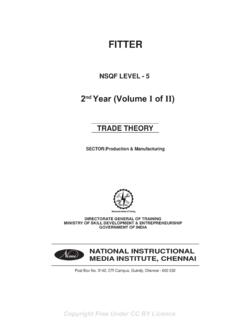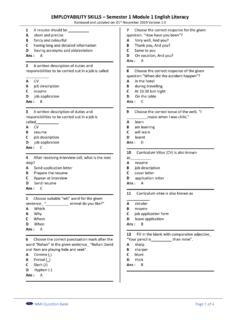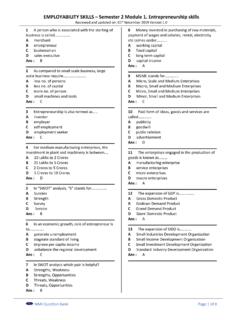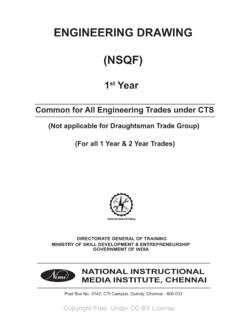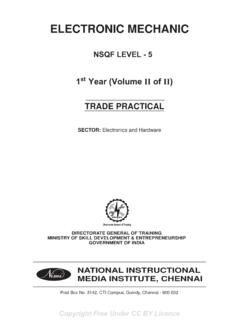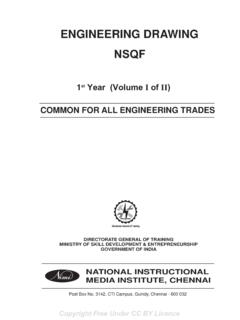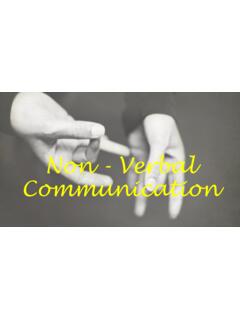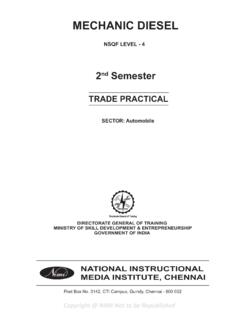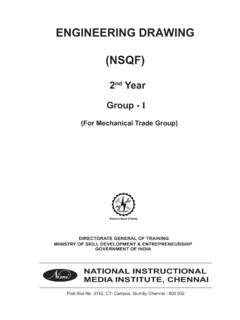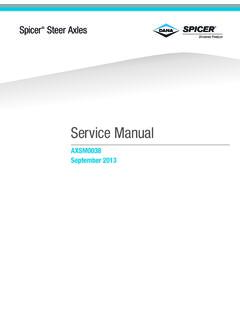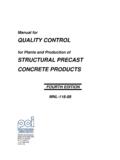Transcription of FITTER - Bharat Skills
1 MINISTRY OF SKILL DEVELOPMENT & ENTREPRENEURSHIPDIRECTORATE GENERAL OF TRAININGCOMPETENCY BASED CURRICULUMCOMPETENCY BASED CURRICULUMCRAFTSMEN TRAINING 0 GOVERNMENT OF INDIA MINISTRY OF SKILL DEVELOPMENT & ENTREPRENEURSHIPDIRECTORATE GENERAL OF TRAINING COMPETENCY BASED CURRICULUMFITTER (Revised in 2017) COMPETENCY BASED CURRICULUM CRAFTSMEN TRAINING SCHEME (CTS)NSQF LEVEL - 5 Curriculum FITTER under CTS MINISTRY OF SKILL DEVELOPMENT & ENTREPRENEURSHIP DIRECTORATE GENERAL OF TRAINING COMPETENCY BASED CURRICULUM COMPETENCY BASED CURRICULUM SCHEME (CTS) Sl. No 1. Introduction Industry Context About the CurriculumEmployability Options2. Job roles and Job Descriptions 3. General information about the CurriculumBasic Information Distribution of training on Hourly basis (Indicative only)Career Progression Pathways4. Trade Syllabus and Training PlanSyllabus Content for Syllabus Content for Semester 2 Syllabus Content for Semester 3 Syllabus Content for Semester 44.
2 Core Skills Syllabus and Training PlanSyllabus Content for Semester 1 Syllabus Content for Semester 2 Syllabus Content for Semester 3 Syllabus Content for Semester 45. Assessment criteria and GuidelinesSpecific Assessable CriteriaGeneric Assessable CriteriaAssessment Guidelines6. Guidelines for Instructors and Paper Setters7. Infrastructure 8. List of Tools & Equipment9. About CTS and various agencies involvedCraftsman Training Scheme (CTS)Various agencies involvedList of trade committee members1 Curriculum for TABLE OF CONTENTS Topics About the Curriculum Employability Options Job roles and Job Descriptions General information about the Curriculum Distribution of training on Hourly basis (Indicative only) Career Progression Pathways Trade Syllabus and Training Plan Syllabus Content for Semester 1 Syllabus Content for Semester 2 Syllabus Content for Semester 3 Syllabus Content for Semester 4 Core Skills Syllabus and Training Plan Syllabus Content for Semester 1 Syllabus Content for Semester 2 Syllabus Content for Semester 3 Syllabus Content for Semester 4 Assessment criteria and Guidelines Specific Assessable Criteria Generic Assessable Criteria Assessment Guidelines Guidelines for Instructors and Paper Setters Tools & Equipment About CTS and various agencies involved Craftsman Training Scheme (CTS) Various agencies involved List of trade committee members Curriculum for FITTER Trade under CTS Page No.
3 2-5 6-7 8 9-56 8-9 57-66 67 29 28-34 35-38 2 Curriculum FITTER under CTS 1. INTRODUCTION Industry Context FITTER trade under Craftsman Training Scheme (CTS) is one of the most popular courses running on pan India through ITIs. The course is of two years (04 semester) duration. It mainly consists of trade ( Skills and knowledge) and Core area (Workshop Calculation and science, Engineering Drawing and Employability Skills ). After passing out the training programme, the trainee is being awarded National Trade Certificate (NTC) by National Council of Vocational Training (NCVT) having worldwide recognition. During the 02 years duration a candidate is trained on subjects Professional Skill, Professional Knowledge, Engineering Drawing, Workshop Science & Calculation and Employability Skills . In addition to this a candidate is entrusted to make/do project work and Extra Curricular Activities to build up confidence.
4 The practical Skills are imparted in simple to complex manner & simultaneously theory subject is taught in the same fashion to apply cognitive knowledge while executing task. The practical part starts with basic fitting with tolerance level and finally to and angular tolerance from 1 to 10 at the end of the course. Total three projects need to be completed by the candidates in a group. After successful completion of this course the trainee shall be able to work in the field of pipe fitting, lathe, drilling, welding , Inspection & measurement, general fitting work observing safety precautions. The trainee can work on dismantling & assembly of various valves, test the accuracy of Machine tools; perform simple repair on machinery, dovetail slides and assemble with location dowel pins, stud and bolts and prepare snap gauge for checking diameters to an accuracy of mm, etc.
5 About the Curriculum This Competency based Curriculum Standard has been developed in keeping with the Qualification of FITTER in the National Qualifications Register under the Craftsman Training Scheme (CTS)1 of the Government of India. The Curriculum Standard provides a structure for developing industry aligned practical Skills and theoretical knowledge for performing various tasks of an FITTER as defined in the National Classification of Occupations (NCO)2. The objective of this course is to develop competence in the learners in performing the various tasks required of an FITTER by imparting training on the practical Skills and their underpinning knowledge and generic abilities using a structured, outcome based training approach. This involved focusing on hands on practical training and assessment of specified learning outcomes. The areas of competence and the key learning outcomes covered in the course are as follow: Sr.
6 No. Broad Areas of Competence Key Learning Outcomes 1 Plan and organise work 1. Plan and organize the work to make job as per specification applying different types of basic fitting operation and Check for dimensional accuracy. [Basic fitting operation marking, Hacksawing, Chiseling, Filing, Drilling, Taping and Grinding etc. Accuracy: ] Joining techniques for sheet metal and metal 2. Manufacture simple sheet metal items as per drawing and join them by soldering, brazing and riveting. 1 For further details on CTS please refer to section 9 of this document 2 The NCO classification code for the job roles that this course is aligned to is given in section 2 of this document 3 Curriculum for FITTER Trade under CTS components 3. Join metal component by arc welding observing standard procedure.
7 4. Cut and join metal component by gas (oxy-acetylene) 5. Join metal components by riveting observing standard procedure. Producing metal components 6. Produce components by different operations and check accuracy using appropriate measuring instruments.[Different Operations - Drilling, Reaming, Taping, Dieing; Appropriate Measuring Instrument Vernier, Screw Gauge, Micrometer] 7. Make different fit of components for assembling as per required tolerance observing principle of interchangeability and check for functionality. [Different Fit Sliding, Angular, Step fit, T fit, Square fit and Profile fit; Required tolerance: mm, angular tolerance: 30 min.] 8. Produce components involving different operations on lathe observing standard procedure and check for accuracy. [Different Operations facing, plain turning, step turning, parting, chamfering, shoulder turn, grooving, knurling, boring, taper turning, threading (external V only)] 9.
8 Make & assemble components of different mating surfaces as per required tolerance by different surface finishing operations using different fastening components, tools and check functionality. [ Different Mating Surfaces Dovetail fitting, Radious fitting, Combined fitting; Different surface finishing operations Scraping, Lapping and Honing; Different fastening components Dowel pins, screws, bolts, keys and cotters; Different fastening tools-hand operated & power tools, Required tolerance - , angular tolerance 10 min.] Performing pipe fitting 10. Apply a range of Skills to execute pipe joints, dismantle and assemble valves & fittings with pipes and test for leakages.[Range of Skills Cutting, Threading, Flaring, Bending and Joining ] 2 Making gauges and drill jigs 11. Make different gauges by using standard tools & equipment and checks for specified accuracy.
9 [Different Gauges Snap gauge, Gap gauge; Specified Accuracy - ] 12. Make drill jig & produce components on drill machine by using jigs and check for correctness. 3 Assembly and fitting of pneumatic and hydraulic components 13. Identify, dismantle, replace and assemble different pneumatics and hydraulics components. [Different components Compressor, Pressure Gauge, Filter Regulator Lubricator, Valves and Actuators.]. 14. Construct circuit of pneumatics and hydraulics observing 4 Curriculum FITTER under CTS standard operating procedure& safety aspect. 4 Maintenance and Repair 15. Plan & perform simple repair, overhauling of different machines and check for functionality. [Different Machines Drill Machine, Power Saw, Bench Grinder and Lathe] 16. Plan, dismantle, repair and assemble different damaged mechanical components used for power transmission & check functionality.
10 [Different Damage Mechanical Components Pulley, Gear, Keys, Jibs and Shafts.] 17. Plan & perform basic day to day preventive maintenance, repairing and check functionality.[Simple Machines Drill Machine, Power Saw and Lathe Erection and testing of simple machine tools 18. Plan, erect simple machine and test machine tool accuracy. [Simple Machines Drill Machine, Power Saw and Lathe]. 11. Generic Skills Health and Safety Environment regulation and housekeeping Mathematics Science Engineering drawing Productivity and Quality Personal Finance and Entrepreneurship Planning and organisation 19. Recognize & comply safe working practices, environment regulation and housekeeping. 20. Understand and explain different mathematical calculation & science in the field of study including basic electrical. [Different mathematical calculation & science -Work, Power & Energy, Algebra, Geometry & Mensuration, Trigonometry, Heat & Temperature, Levers & Simple machine, graph, Statistics, Centre of gravity, Power transmission, Pressure] 21.]
